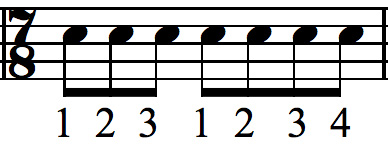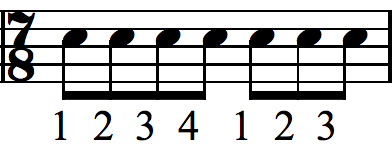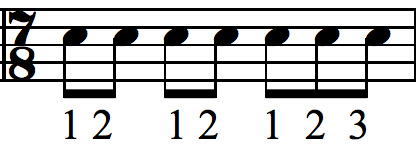|
Music for the Modern Dance Class
|
|||
|
|
Simple Meter
Described in the simplest terms, meter is the repetition of counts or a grouping of counts. Based on these groupings, music is broken up in to smaller units called bars or measures. The organization of beats, or pulses and their subdivisions within each measure define the meter as duple, triple, compound, or odd.
Note: it is assumed that in duple and triple meters, the subdivisions for each individual count are in groupings of two. In compound meters, subdivisions are in groupings of three.
The term: Duple meter implies that the measures are divisible by groups of two counts (or larger groups divisible by two). 2/4, 4/4, 2/2, 4/2, etc. In 2 / 4, for example, there are two counts per measure, and the quarter note is the note value for each count.
(A dancer might count this in 8)
(A dancer might count this as 1 & 2 & 3 & 4 & 5 & 6 & 7 & 8 & etc.)
In triple meter, the measures are divided up into groups of three counts. The most common time signatures in triple meter are 3 / 8, and 3 / 4.
(A dancer may count this as 1 2 3 2 2 3 3 2 3 4 2 3) OR (1 & a 2 & a 3 & a 4 & a) Compound Meter
Compound meters are usually signified by 6/8, 9/8, or 12/8. These are meters, which may have a duple or triple “feel,” as the above meters, but are characterized by the fact that the individual counts are divided by three rather than two. In 6 / 8, for example, there is primarily a duple feel, the counts are divided by two, rather than three. 9 / 8 would be considered a triple meter with triplet subdivisions, or triple compound. See the Meter Cheat Sheet for comparisons of simple and compound meter
(A dancer may count this as 1 & a 2 & a 3 & a 4 & a etc.)
(A dancer may count this as 1 & a 2 & a 3 & a 1 & a 2 & a 3 & a) OR (1 & a 2 & a 3 & a 4 & a 5 & a 6 & a) Odd Meter Odd meters usually include, but are not limited to 5/4, 5/8, 7/4, and 7/8, meaning they have five and seven counts per measure, respectively. These are referred to as being odd meters because they are asymmetrical and, aurally, go against the even phrases of 4 or 8, or their multiples, which we are used to hearing. Odd meters can be very interesting because they can add or omit moments in time and space which would normally exist in symmetrical phrases to change the feel, shape, and character. (A dancer may also count this 1 2 3 4 5 2 2 3 4 5 3 2 3 4 5 4 2 3 4 5) Generally, these types of meters are broken up into smaller groups. For example, 5/8 might be broken up into two smaller micro-phrases, one of three counts and one of two counts or vice versa. For example 3 + 2
or 2 + 3
Similarly 7/8 might be broken up in sets of 3 + 4
or 4 + 3
Musicians commonly make the divisions even further, for example: 3 + 2 + 2
or 2 + 2 + 3
Meters like these might be used to create a phrase, which might be, in nature, less stable, or to combine different qualities of movement. For instance, there might be 3 counts of movement with a pendular quality, commonly associated with triple, followed by 4 counts of movement, which is more “straight.” Mixed Meter It is not uncommon for modern dance teachers to combine meters. A simple example this would be the use of 4 / 4 and 12 / 8.
|
||
|---|---|---|---|
| Copyright 2007 Neil Dunn | |||


















